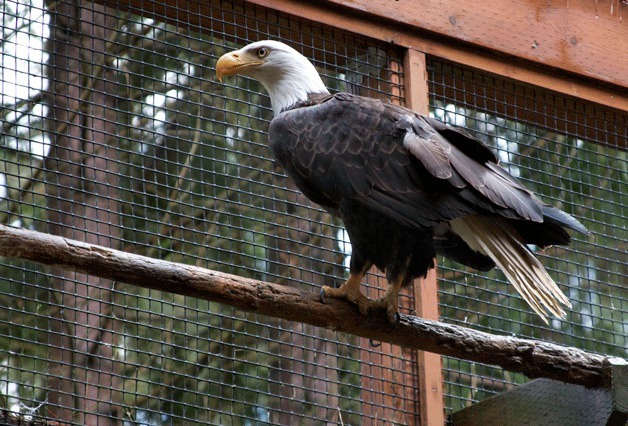Soaring above the Sound on a crisp autumn day last October, a bald eagle – one of nature’s most majestic creatures – had little inkling that he would soon be deprived of his freedom of flight, and that, for him, the months ahead would see a prolonged and painful rehabilitation, recovery and finally, rejuvenation.
The unnamed eagle arrived at the West Sound Wildlife Shelter broken and battered. It was not the ferocity of humans or nature, however, that injured him, but his own kin — a rival male bald eagle was the culprit who left him battered and in need of healing care.
Through the expert help of the shelter’s staff and volunteers, throughout the process of the X-rays, pain medications, antibiotics and flying tests, the eagle maintained his dignity.
“Wild animals don’t like to show pain,” said Michael Pratt, director of wildlife services at the shelter.
But all the time spent to rehabilitate the bird of prey has well-prepared him.
“Birds, especially eagles, they’re like flying athletes. They have to be 100 percent. They have to fly great,” Pratt said.
On Sunday, the eagle will fly once again, leaving his earthly confines — a flying pen he shares with another eagle who will be released later — to take to the skies.
Lisa Horn, executive director of the shelter, said there was no sadness for the many staff and volunteers who nursed the bird back to health.
“It’s a celebration for us,” she said.
And it’s not like the eagle and the shelter crew became close friends.
“We don’t give him an opportunity to like us,” Pratt explained. “We want our patients to hate us when they leave.”
Shelter officials said the bird is one of just over a thousand animals the shelter has cared for in 2012, and will be released back into the wild near the wildlife shelter on Sunday, Jan. 13.
“Everybody’s really excited,” Horn said. “It’s an enormous success.”
While the release will remain private to facilitate an easy transition, those at the shelter encourage community members to rejoice in this majesty of a bird reborn, and especially to alert the shelter or animal hospitals in the area of injured wildlife.
“When people are out and they see an animal there is help,” Pratt said, “take your time to help.”



